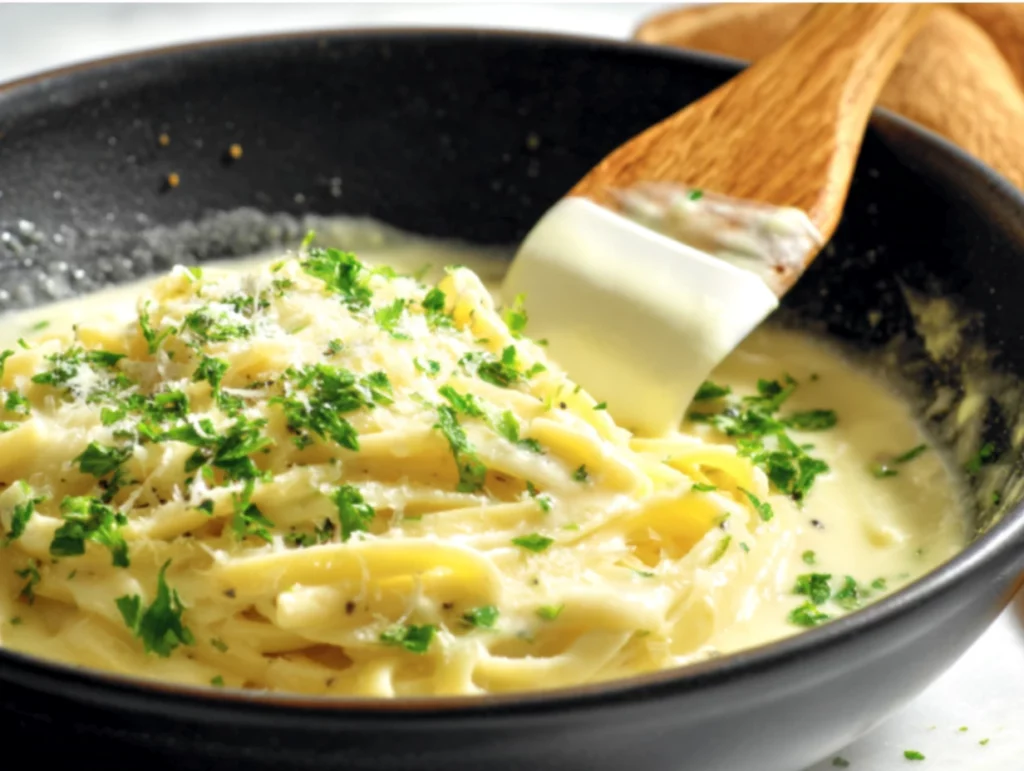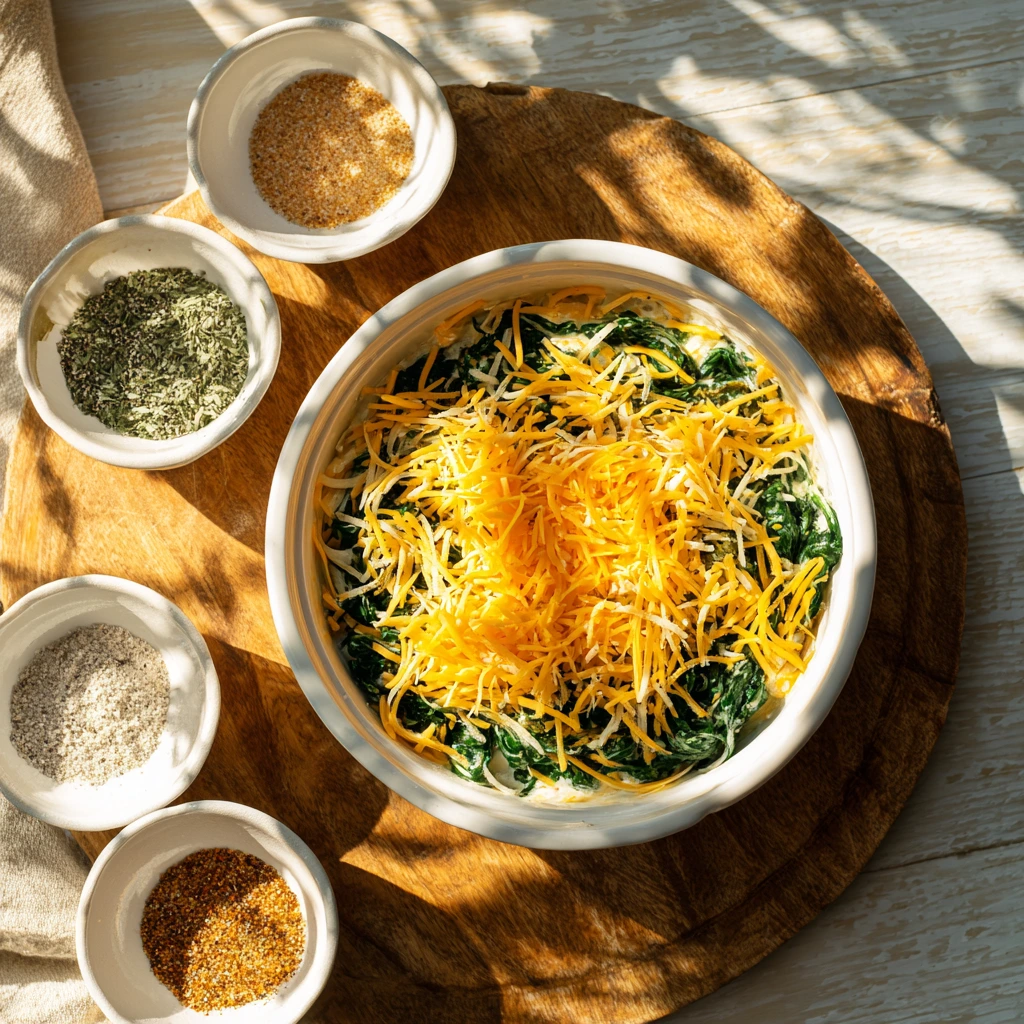If you’re anything like me, pasta is the go-to comfort food on a busy weeknight. It’s warm, satisfying, and super versatile. But what if I told you there’s a way to make it just as creamy and indulgent without relying on heavy cream or a stick of butter? Enter: Cottage Cheese Pasta Sauce—a creamy, high-protein twist that has quickly become one of my favorite pasta upgrades.
I first started experimenting with cottage cheese in sauces when I was looking for healthier alternatives to Alfredo. And to be honest, I was skeptical. Would it be too tangy? Too chunky? Not indulgent enough? But with a few simple tweaks and a quick blend in the food processor, the result was a velvety, rich sauce that clings to pasta like a dream. Plus, it’s packed with protein and doesn’t leave you feeling overly heavy after dinner. Win-win!
So today, I’m walking you through this easy recipe that’s perfect for weeknights, meal prep, or even those “what do I make with this leftover pasta?” moments. Let’s dive in!
Why You’ll Love This Cottage Cheese Pasta Sauce
Creamy but light – All the richness of a cream sauce without the actual cream.
High in protein – Thanks to cottage cheese and Parmesan.
Super fast – Comes together in under 15 minutes.
Customizable – Add herbs, veggies, or protein to make it your own.
Kid-friendly – Seriously, they won’t even notice there’s cottage cheese in it.
Ingredients You’ll Need
Here’s what you’ll want to grab before you get started:
1 cup cottage cheese – Full-fat gives you the creamiest result, but low-fat works too.
1/4 cup grated Parmesan cheese – Adds that salty, umami punch.
1/2 cup milk or pasta water – Adjust based on your desired consistency.
1 garlic clove, minced – Fresh is best for flavor.
1 tablespoon olive oil – For sautéing the garlic.
1/2 teaspoon salt
1/4 teaspoon black pepper
1/4 teaspoon dried basil or Italian seasoning
Pasta of choice, cooked and drained – Any noodle works!
Chopped parsley or basil (optional) – For garnish and freshness.
STEP 1: Blend the Base Sauce
Start by adding your cottage cheese, Parmesan, milk (or pasta water), salt, pepper, and dried basil into a blender or food processor. Blend it until completely smooth—no lumps allowed! You want this to have the texture of a rich cream sauce, so give it an extra 10-15 seconds if needed to get that perfectly silky consistency.
Pro Tip: If your cottage cheese is very thick, start with the milk or pasta water and slowly increase to loosen it up. You’re aiming for a pourable sauce, not a dip.
STEP 2: Sauté the Garlic
In a medium skillet, heat your olive oil over medium heat. Add the minced garlic and sauté for about 1 minute, just until it becomes fragrant. Be careful not to burn it—you want it golden and mellow, not bitter.
This step adds a subtle depth of flavor to the sauce and ensures the garlic isn’t too overpowering (blending raw garlic into the sauce can be a bit too sharp).
STEP 3: Heat the Sauce
Now that the garlic is ready, pour in your blended cottage cheese sauce. Stir continuously as it heats—this only takes about 2 to 3 minutes. You’ll notice it starting to thicken slightly, especially if you used pasta water (the starch helps it cling beautifully to your noodles).
If the sauce seems too thick, don’t panic—just splash in a little more milk or pasta water until it reaches your perfect consistency.
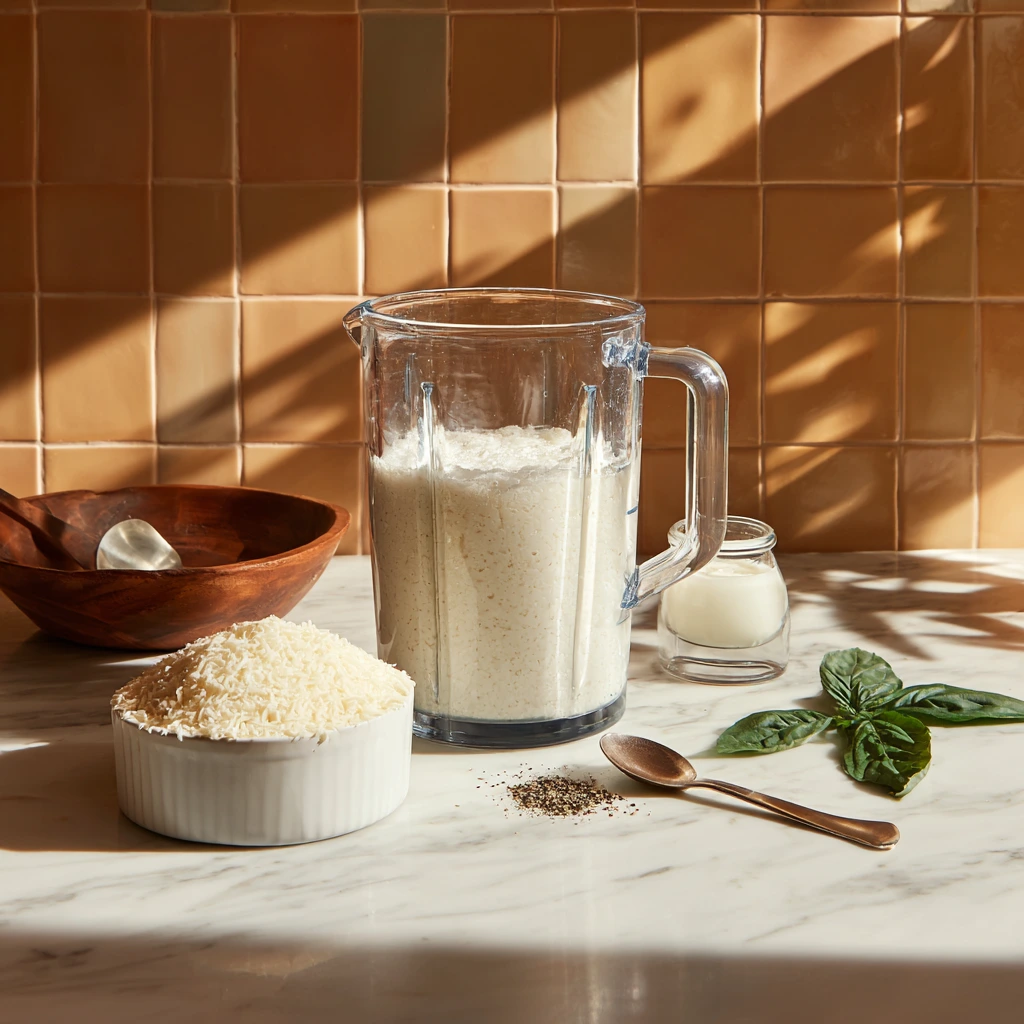
How to Finish & Customize Your Cottage Cheese Pasta Sauce
Now that we’ve got our creamy, garlic-infused cottage cheese sauce simmering away, let’s move on to the best part—bringing it all together with your favorite pasta and adding those personal touches that make this dish totally your own.
This is the moment when your kitchen smells like something out of an Italian trattoria and you realize, yes, you can absolutely make a decadent-tasting pasta sauce with cottage cheese. And it’s so much easier than you’d think.
Let’s finish it up!
STEP 4: Toss the Pasta with the Sauce
Once your sauce is warmed through and thickened to your liking, it’s time to bring in the pasta. Add your cooked and drained pasta directly into the skillet with the sauce. Use tongs or a spatula to toss everything together, making sure every noodle is beautifully coated.
Tip: If the sauce feels a bit too thick at this stage, just add a splash of reserved pasta water (or milk) until it reaches your desired creaminess. Pasta water is especially helpful because its starch helps bind the sauce even more effectively.
This step only takes about 1-2 minutes, just enough time to warm the pasta through and allow it to absorb a bit of that cheesy goodness.
STEP 5: Garnish and Serve
Plate your pasta straight from the skillet and, if you’re feeling fancy, sprinkle some fresh chopped parsley or basil over the top. Not only does it add a pop of color, but it also brings a bright, herby note that balances out the richness of the sauce.
A little extra grated Parmesan on top? Always a good idea.
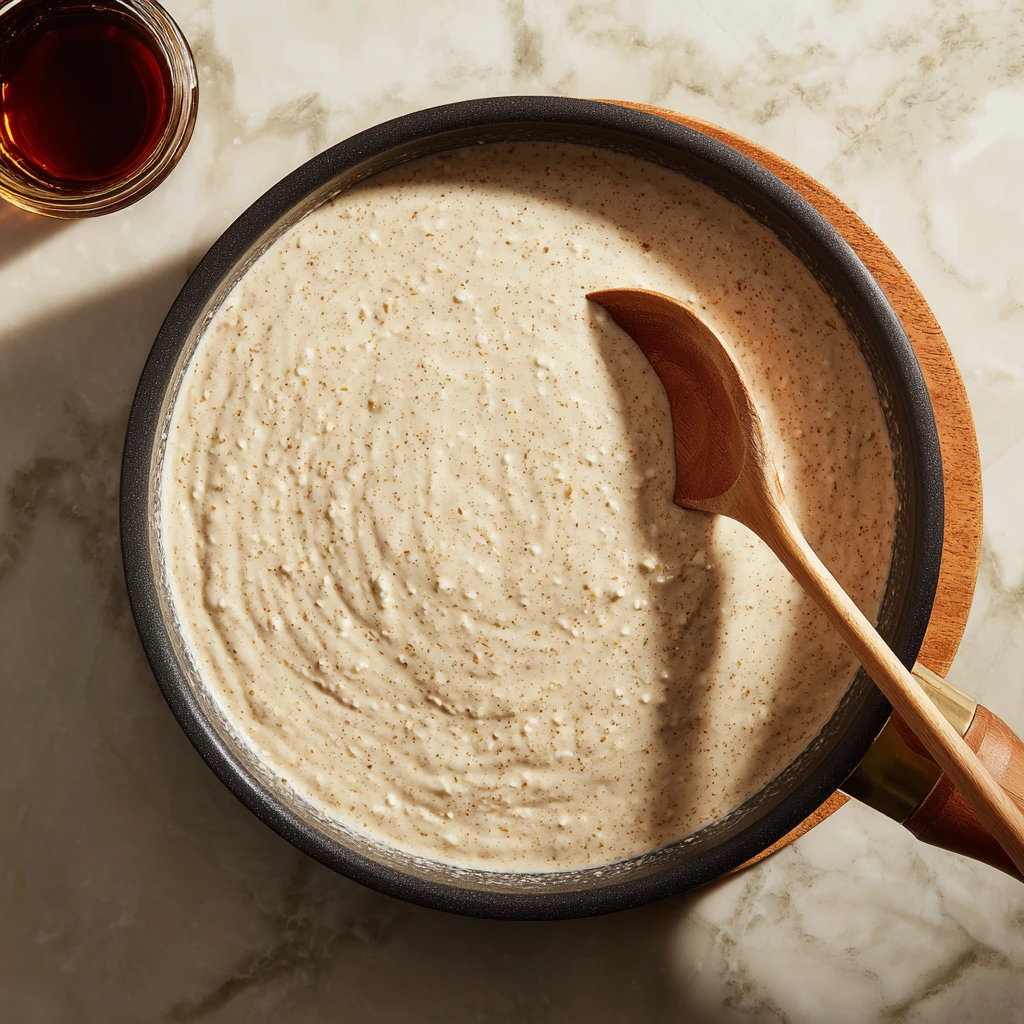
Customization Ideas & Add-Ins
One of the reasons I keep coming back to this recipe is how easy it is to adapt based on what I have in the fridge—or what I’m craving. Here are a few of my go-to ways to jazz things up:
Add veggies: Roasted cherry tomatoes, steamed broccoli, sautéed mushrooms, or wilted spinach are all amazing additions.
Boost the protein: Stir in shredded rotisserie chicken, grilled shrimp, or even some cooked chickpeas for a vegetarian option.
Try different herbs: Swap out the basil for oregano, thyme, or even fresh dill depending on your flavor mood.
Use whole grain or legume pasta: Want even more fiber or protein? Whole wheat or lentil-based pasta pairs beautifully with this sauce.
Spice it up: Add a pinch of red pepper flakes to the garlic oil before you add the sauce for a little heat.
How to Store & Reheat Leftovers
This sauce holds up surprisingly well in the fridge, making it a great option for meal prep or quick leftovers the next day.
To store: Transfer leftovers to an airtight container and refrigerate for up to 3 days.
To reheat: Warm gently in a skillet over low heat. Add a splash of milk or water to loosen the sauce and stir frequently to keep it smooth.
Just a heads-up—since cottage cheese is lower in fat than cream or butter, the sauce can thicken more in the fridge. That’s totally normal. A bit of extra liquid and some gentle heat will bring it right back to life.
Make It a Meal: Serving Suggestions
This creamy pasta can absolutely stand on its own, but if you want to round out the meal, here are a few pairing ideas:
Garlic bread or a crusty baguette – Because no one wants to leave sauce behind in the bowl.
A crisp green salad – Something simple like arugula with lemon vinaigrette balances the richness.
Grilled vegetables – Zucchini, eggplant, or bell peppers work beautifully here.
This dish is simple enough for weeknights but tasty enough to serve to guests—and trust me, no one will guess it’s made with cottage cheese. They’ll just ask for seconds.
Cottage Cheese Pasta Sauce FAQs & Final Thoughts
Before you dive into your own bowl of creamy, protein-packed pasta, let’s cover some of the most frequently asked questions I get about this Cottage Cheese Pasta Sauce. Whether you’re new to cooking with cottage cheese or just curious about substitutions, I’ve got you covered.
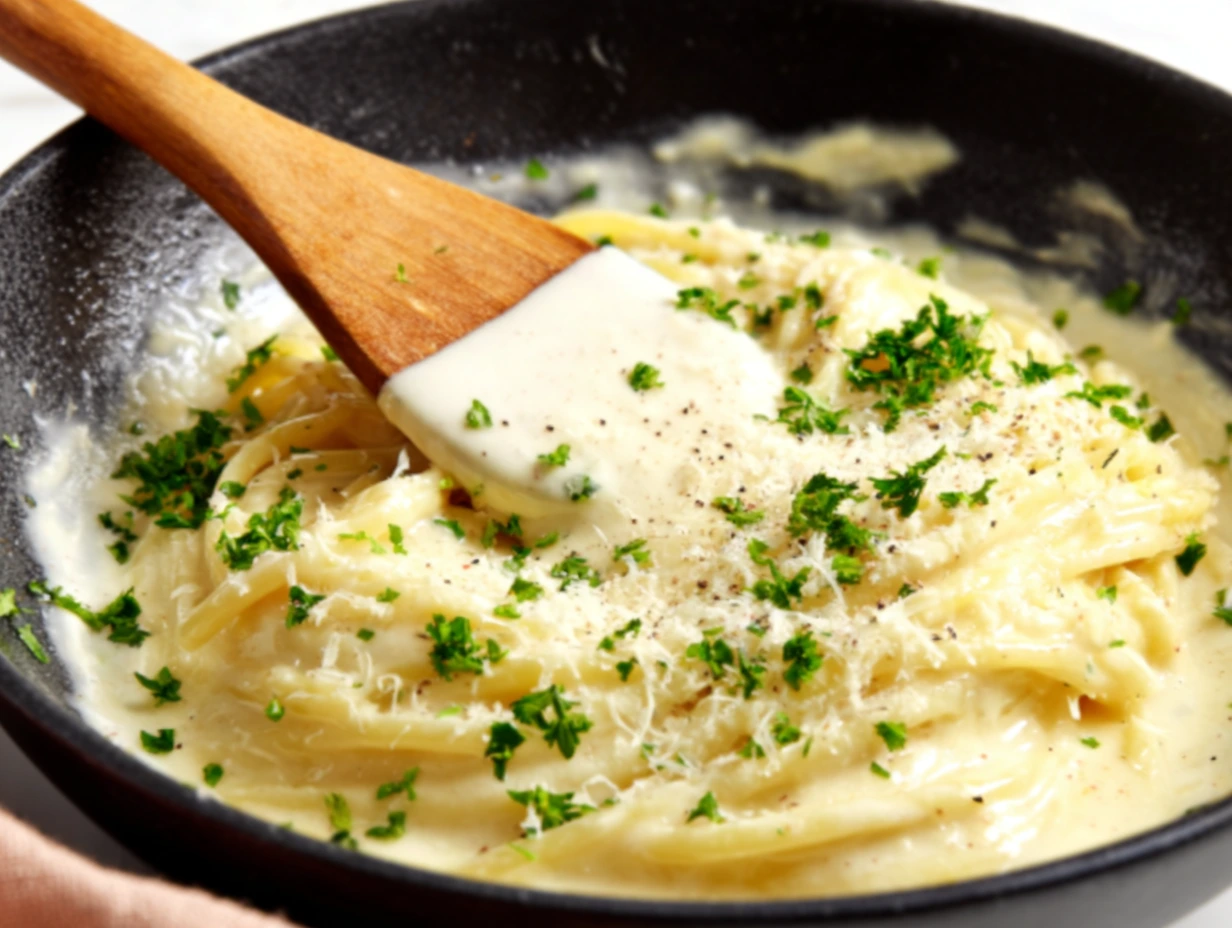
Frequently Asked Questions
Can I use low-fat or fat-free cottage cheese?
Yes, you absolutely can. The sauce will still blend up creamy, but it might be a little less rich than if you use full-fat cottage cheese. If you find it lacking in texture, try adding a little extra Parmesan or a tablespoon of olive oil to balance it out.
What’s the best pasta for this sauce?
This sauce pairs well with almost any pasta. I personally love it with fettuccine or penne because the sauce really clings to those shapes. But feel free to use spaghetti, shells, or even a chickpea or lentil-based pasta if you want to add more protein and fiber.
Can I make this sauce vegan?
You sure can! Use a plant-based cottage cheese (yes, they exist and are easier to find now) and skip the Parmesan or replace it with a vegan cheese alternative or nutritional yeast. Just be sure to taste and adjust the seasoning since dairy-free versions can vary in flavor.
Is this sauce good for meal prep?
Yes! It reheats well, especially if you add a splash of milk or water to loosen it up. I recommend storing the pasta and sauce together in one container for best results, but you can also store the sauce separately and toss it with fresh pasta when ready.
Can I freeze this sauce?
Technically, yes—but with a caveat. Cottage cheese can separate slightly when frozen and thawed. If you do freeze it, re-blend it after thawing and reheat gently with added liquid to smooth it back out.
How can I make the sauce even thicker?
If your sauce feels too thin, let it simmer in the pan for an extra 2–3 minutes while stirring frequently. The Parmesan helps it thicken naturally, and the starch from pasta water (if used) also plays a role. You can also add a tablespoon of cream cheese for extra richness and body.
Does it taste like cottage cheese?
Not at all. Once it’s blended and cooked with garlic and Parmesan, the tangy flavor of the cottage cheese mellows out. The end result is creamy, savory, and surprisingly close to Alfredo—but lighter and higher in protein.
Final Thoughts: Why You’ll Want to Make This Again and Again
This Cottage Cheese Pasta Sauce has earned a regular spot in our weekly meal rotation—and I have a feeling it’s about to earn a spot in yours, too. It’s quick, customizable, and gives you that comforting, creamy pasta fix without relying on heavy ingredients.
What I love most is how adaptable it is. Whether you’re keeping things simple with garlic and herbs or dressing it up with roasted veggies and chicken, the base sauce holds it all together beautifully. Plus, it’s one of those dishes that tastes fancy but takes barely 20 minutes to pull together.
Print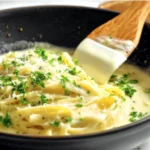
Cottage Cheese Pasta Sauce
- Author: Andrew Recipes
Description
This Cottage Cheese Pasta Sauce is a creamy, high-protein alternative to traditional Alfredo or cream-based sauces. It blends cottage cheese into a velvety texture that clings beautifully to pasta, while offering a lighter and healthier option. Ideal for quick weeknight meals, it pairs wonderfully with your favorite noodles and can be easily customized with herbs, spices, or vegetables.
Ingredients
1 cup cottage cheese
1/4 cup grated Parmesan cheese
1/2 cup milk or pasta water (adjust for consistency)
1 garlic clove, minced
1 tablespoon olive oil
1/2 teaspoon salt
1/4 teaspoon black pepper
1/4 teaspoon dried basil or Italian seasoning
Pasta of choice, cooked and drained
Chopped parsley or basil for garnish (optional)
Instructions
In a blender or food processor, combine the cottage cheese, Parmesan, milk or pasta water, salt, pepper, and basil. Blend until completely smooth.
Heat the olive oil in a skillet over medium heat. Add the minced garlic and sauté for 1 minute until fragrant.
Pour in the blended cottage cheese mixture and cook for 2 to 3 minutes, stirring constantly, until heated through and slightly thickened.
Toss the cooked pasta in the sauce, adding more pasta water if needed to reach desired consistency.
Serve immediately, garnished with fresh herbs if desired.
Notes
This sauce is naturally thick and creamy without needing heavy cream or butter. For a vegan variation, use plant-based cottage cheese and omit the Parmesan. Roasted vegetables, sautéed spinach, or cooked chicken can be added for a heartier dish. Use whole-wheat or legume-based pasta to boost fiber and protein.
